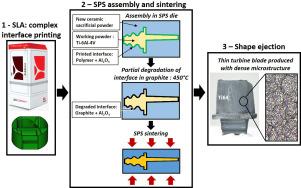通过 SPS 和 3D 打印混合技术生产用于钛合金复杂形状的人工陶瓷粉末混合物
IF 4.5
2区 工程技术
Q2 ENGINEERING, CHEMICAL
引用次数: 0
摘要
由于模具结构复杂,通过火花等离子烧结技术(SPS)生产复杂形状的产品具有挑战性。DEFORMINT "方法将三维打印与 SPS 和牺牲粉末相结合,制造出完全致密的形状。部件和牺牲部分使用相同的粉末可避免变形,但钛合金(如 Ti-6Al-4 V)的高成本限制了其应用。SPS 实验建立了一个致密化模型,并预测了一个厚锥体和一个薄而复杂的涡轮叶片的变形情况,显示出与实验结果的良好相关性。新的牺牲混合物不会产生额外的变形,因此可以制造涡轮叶片。唯一的缺陷是接触界面处有 600 μm 的集肤效应。本文章由计算机程序翻译,如有差异,请以英文原文为准。

Sacrificial ceramics powders mix for titanium alloys complex shapes production by hybridization of SPS and 3D printing
The production of complex shapes via Spark Plasma Sintering (SPS) is challenging due to intricate die configurations. The “DEFORMINT” approach combines 3D printing with SPS and sacrificial powder to fabricate fully dense shapes. Using the same powder for both the component and sacrificial part avoids distortions, but high costs of titanium alloys like Ti-6Al-4 V are limiting. This study tested a low-cost ceramic powder that mimics Ti-6Al-4 V's behavior, forming a pseudo-isostatic configuration above 1250 K. SPS experiments established a densification model and predicted distortions in a thick cone and a thin, complex turbine blade, showing good correlation with experimental results. The new sacrificial mix does not imply additional deformation and allows the fabrication of turbine blades. The only defect is a 600 μm skin effect at the contact interface.
求助全文
通过发布文献求助,成功后即可免费获取论文全文。
去求助
来源期刊

Powder Technology
工程技术-工程:化工
CiteScore
9.90
自引率
15.40%
发文量
1047
审稿时长
46 days
期刊介绍:
Powder Technology is an International Journal on the Science and Technology of Wet and Dry Particulate Systems. Powder Technology publishes papers on all aspects of the formation of particles and their characterisation and on the study of systems containing particulate solids. No limitation is imposed on the size of the particles, which may range from nanometre scale, as in pigments or aerosols, to that of mined or quarried materials. The following list of topics is not intended to be comprehensive, but rather to indicate typical subjects which fall within the scope of the journal's interests:
Formation and synthesis of particles by precipitation and other methods.
Modification of particles by agglomeration, coating, comminution and attrition.
Characterisation of the size, shape, surface area, pore structure and strength of particles and agglomerates (including the origins and effects of inter particle forces).
Packing, failure, flow and permeability of assemblies of particles.
Particle-particle interactions and suspension rheology.
Handling and processing operations such as slurry flow, fluidization, pneumatic conveying.
Interactions between particles and their environment, including delivery of particulate products to the body.
Applications of particle technology in production of pharmaceuticals, chemicals, foods, pigments, structural, and functional materials and in environmental and energy related matters.
For materials-oriented contributions we are looking for articles revealing the effect of particle/powder characteristics (size, morphology and composition, in that order) on material performance or functionality and, ideally, comparison to any industrial standard.
 求助内容:
求助内容: 应助结果提醒方式:
应助结果提醒方式:


